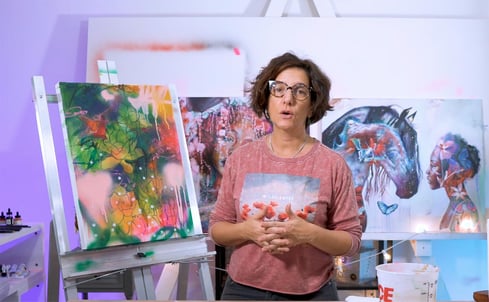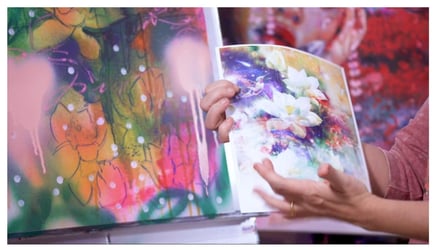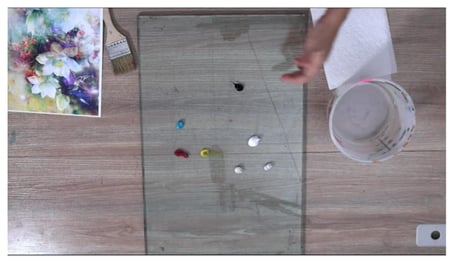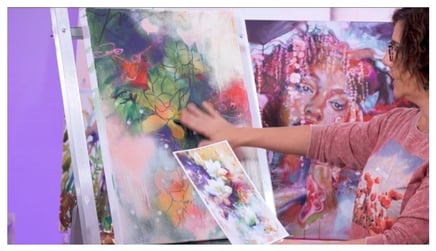As an artist, you instinctively know when a work of art as a whole is pleasing to the eye. There is a silent but strong beckoning into the world of the piece. Why? It is likely because the artist who created it knew how to create resting space, which is one of the most important elements of art.
If you truly want your art to speak straight to the hearts of your viewers, it’s vital to make an atmosphere in a painting that is detailed, fluid, and compelling, but not busy, overwhelming, or contrived. Learning how to add resting space to your paintings is an essential painting technique for you to master.
What Is Resting Space & Why Your Painting Needs It

Photo caption: Elli Milan explains what resting space in a painting is. Photo courtesy of Milan Art Institute Art Club.
A successful painting has elements of visual interest without being too busy or too bland. The viewer knows exactly what the subject is and can appreciate the detail rendered in it, as well as how the background frames the subject. This art technique allows you to bring a level of excellence to your paintings that subtly conveys your passion and mastery as an artist.
“Resting space” refers to the painting technique that allows the viewers’ eyes to “rest” and not be overwhelmed by all of a painting’s elements at once. This balances the piece and complements the subject.
Implementing resting space is a key way to seamlessly integrate your foreground with your background. It also adds a look of effortless refinement.
Additionally, this element of art is a key ingredient to creating artwork that is sellable. Potential collectors are eager to purchase paintings that open up their space.
What You’ll Need to Create Resting Space
The tool that is vital to achieving a blended, semi-transparent look to the resting space is a chip brush. These brushes are really easy to find at art stores or any hardware store. The accessibility and low price of these brushes are game changers! How great is it that you can add so much quality to your piece for such a bargain!?
You can easily use this painting technique with both acrylics and oils. If you start with acrylics, keep in mind that you can glaze different colors of oil on top of the acrylics to create that juicy, transcendent quality that collectors love!
First, Choose Your Resting Space Areas and Make Edits

Photo caption: Find the spots where you can create resting space on your painting. Photo courtesy of Milan Art Institute Art Club.
Once your initial layers have dried, you can determine where this art element will be. It should be placed in a location that complements the subject. This is also a great way to minimize and edit out areas of busyness.
This may be difficult, but don’t get too attached to the marks you’ve made in the first layers of your painting.
As far as color goes, choose any you’d like! It’s worth noting that choosing one main color with transitions in tone will unify the piece and create good composition.
Tip: If you choose white, vary the shades from a gray white to a buttery and creamy white by adding a touch of other colors. Don’t ever only use black or white.
Next, Be Mindful of Technique

Photo caption: Be mindful of how you use your art materials in your process. Otherwise, the results will be milky. Photo courtesy of Milan Art Institute Art Club.
Be sure NOT to mix any water with the paint, the colors will look milky and won’t adhere to the surface to create the soft, yet powerful effect this painting technique is known for.
Also, don’t apply too much paint to the brush. For you to successfully render this element of art in your work, coat your brush, but don’t fill it so full of paint that it completely covers your work.
The best way to handle the brush is to use a scrubbing motion, called “scumbling.” There is no need to lift the brush for this technique; that’s how you get really beautiful soft transitions.
Video caption: Oil Painting Techniques | Scumbling Oil Painting Technique With Elli Milan
Finally, Bring Out the Forms of Your Subject

Photo caption: Look at your painting to identify the forms. Photo courtesy of Milan Art Institute Art Club.
Be sure to add darker colors to other areas of the painting to amplify the contrast. Also, make sure to scumble all the way up to your subject, or else there will be an awkward sort of halo around it.
After you’re done scumbling, you can move on to your smaller brushes to render out the forms from dark to light.
Overall Ease and Value of Adding Resting Space
Grab your colors, your chip brush, and scumble away! You will be so amazed at your results, and how dramatically elevated the look of your paintings become.
With this quick and easy painting technique in your creative arsenal, you will impact your viewers and collectors in a profoundly transformative way. They will undoubtedly become fans of your work, and want to support you again and again.
To discover other important techniques and processes, join our Milan Art Community to get access to more content like this and connect with other artists from around the world.
More Articles to Help You Up Your Art Game
Young Artists in Action: How Art Helps Teens Know Themselves
3 Reasons Why Skill Is Non-Negotiable
Art Resources Round Up: 25 Helpful Articles for Your Art Career

